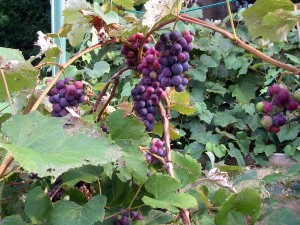Learn about grapes, including how to plant and grow them.
Listen to Podcast:
How to Grow: Grapes
 Whether you’re growing them for juice, wine or fresh eating, grapes (Vitis) are a great home garden fruit. They’re self pollinating and productive so you can grow just one vine. Grapes can be trained to grow in small space or can be trained over a pergola or arbor. They require little care besides pruning, can grow on less than ideal soils, and fruit for up to 25 years or more. I often recommend people grow them because they fit in small spaces really easily allowing you to have tables grapes right out your door.
Whether you’re growing them for juice, wine or fresh eating, grapes (Vitis) are a great home garden fruit. They’re self pollinating and productive so you can grow just one vine. Grapes can be trained to grow in small space or can be trained over a pergola or arbor. They require little care besides pruning, can grow on less than ideal soils, and fruit for up to 25 years or more. I often recommend people grow them because they fit in small spaces really easily allowing you to have tables grapes right out your door.
With some new varieties adapted to the Northeast, we now can grow more seeded or seedless table grapes for fresh eating and even wine grapes.
When to Plant
Plant bare root grape vines in spring as soon as the soil can be worked. Plant container grapes in spring or early summer so they have enough time to get established before winter.
Where to Plant
Grapes need full sun and well-drained soils to grow their best. They grow best on loose loamy soil but can grow in clay. Plant on a south or east facing slope to allow the leaves to dry out quickly reducing the amount of disease on the plant.
How to Plant
Prepare the soil by removing any grass or weeds and tilling deeply. Plant grapes 8-feet apart in rows spaced at least 6- to 8-feet apart. Dig a hole twice the diameter of the root ball of the grape plant and as deep as it was in the container. Place a stake in the hole to support the one-year old cane. Keep well watered the first year. Mulch around the base of the plant with a 2- to 3-inch thick layer of straw or bark mulch.
Care and Maintenance
Grapes can be grown on a fence (trellis) or structure such as a pergola. I like to use the 4-armed Kniffen system for trellising grapes. Here’s how it works.
Drive 7- to 8-foot long metal or wooden posts into the ground so they stand 6 feet tall. Space posts 10 feet apart in the rows. Brace the end posts with wire attached to an anchor in the ground. Run two strands of heavy gauge wire, 3 and 5 feet above the ground along the row, attaching it to every post.
After planting, prune the vine to one cane and attach it to the bottom wire. After the first winter, top the main cane at 6 feet tall and attach it to the top wire. Cut back all side shoots, but leave 4 to 6 buds on the shoot near each wire. The third winter tie two canes going in opposite directions to each wire for a total of 4 producing canes. Prune them back to 15 buds. Remove all other canes, but leave one bud on one shoot on each side of each wire for replacement canes. Remove the fruiting canes the next winter and allow the replacement buds to grow into the new side canes. Repeat each year.
For an arbor, train a single stemmed cane up each post until they reach the top of the arbor. Allow a single side cane to develop into the main canes to grow across the arbor. Allow them to grow across the top and cut the one year old canes back to 2 buds each winter to stimulate new growth.
Fertilize grapes with compost each spring. Use netting to discourage birds from eating ripe fruit. Keep good air circulation to avoid rot diseases on the fruit. Control Japanese beetles with traps and Neem oil sprays.
Harvest
Grapes start producing harvestable grapes the second or third year after planting. Harvest bunches for fresh eating once the grapes color up. You can pick over a period of a few weeks as clusters ripen at different times. Wine grapes are picked based on sugar levels (brix) and need testing to be picked at the right time.
Additional Information
Some good seeded table grapes varieties include ‘Bluebell’, Concord’ and ‘Brianna’. Some good seedless table grape varieties to try are ‘Somersett’, ‘Edelweiss’, and ‘Reliance’. For making wine, try some of the new varieties from Minnesota, such as ‘LaCrescent’, ‘Marquette’, and ‘Frontenac’.
Text excepted from the Northeast Vegetable and Fruit Gardening book.
Podcast Transcript
Grapes are one of the oldest known cultivated crops, and after a warm summer, the harvest has begun! While the center of grape growing is in warmer climates, such as California, Italy, and Australia, with the advent of new hardier varieties, cold climate gardeners can join the fun, too.

You don’t need a vineyard to grow a few grape vines for fresh eating. Find a spot with full sun, well drained, fertile soil and build some trellising for them to grow on. Prune heavily each winter,
removing up to 80 per cent of each vine, to keep your grapes from growing wild.
Now for this week’s tip, late blooming annual flowers, such as Verbena bonarienesis, are setting seed now. Either let them fling their seed around the garden willy nilly, or collect some for sowing in specific areas next spring.
From the Vermont Garden Journal on Vermont Public Radio.


